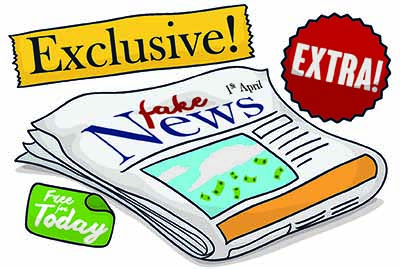
Trending
Fake•News (n.): Navigating a post-truth world
August, 2017
It’s a cringe-worthy question that you might be a little sick of hearing: Who can be trusted in the era of fake news? Thankfully, it’s also a question with an answer: Trust yourself. To do that, however, requires some media literacy on your part—a.k.a., learning how to identify fake news, how to avoid getting fooled by it and how not to inadvertently perpetuate it.
The Rise of Fake News
Publishing lies and propaganda certainly isn’t anything new; historians have records of fake news campaigns going back to ancient Rome and beyond. But as the case with every media tool du jour, the Internet has been leveraged to allow fake news to take on an entirely new life and cultural significance. Of course, the 2016 American presidential election is easy to point to for bringing the online fake news industry to the forefront of popular culture.
The “us versus them” mentality common to election season created an audience that manufacturers of fake news could target with sensational links about the candidates. Social media users could then strategically spread that news like wildfire. These users shared fake links to discredit their opponents, while fake news manufacturers earned advertising revenue for every click that their false stories generated.
Usage & Definitions
Most terms get manipulated at least a little to suit each user’s purposes, but in general, it’s agreed that “fake news” refers to one of three things:
- The “news that is incorrectly reported” definition. There is a lot more to being a journalist than just writing a story. Good journalists fact check, verify their sources and do their best to leave
personal opinions and biases out of the article. Some journalists and media organizations can forget this though, in the rush to meet a deadline. This “lazy journalism” might not be malicious, but it still leads many to label such organizations as manufacturers of fake news. - The “news I don’t agree with” definition. This example describes news or information that runs contrary to one’s goals or world view. In this use of the term, the factual merit of the news is irrelevant to the person, so he or she labels it as “fake” as a way to strategically dismiss it out of hand.
- The “manufactured misinformation” definition. This definition includes news that is purposefully created to mislead the masses, usually to confuse readers, create controversy or further a political agenda. One such example came during the 2016 American presidential election, when it was falsely claimed that Pope Francis had endorsed Donald Trump as his candidate
of choice.
Detecting Fake News
The best defense against fake news is to learn how to detect it. Here are five tips to help you navigate the information highway:
- Always follow the headline to the original source of the article. Once there, do some investigating into both the publisher and the author if one is listed. Ask yourself if they are reputable, and if they use reputable sources. Do a quick Internet search of the publication’s name if you aren’t sure.
- Ask yourself if any organization or political party might benefit from the circulation of the news story. Conversely, ask who might be harmed by it. If the article seems to have no purpose other than to praise or slander someone, it might not be real news.
- Check to see if other news organizations are writing about the story. The more discussion there is, and the more diverse that discussion is, the more likely the story is to be real. Opinions and commentary can vary. Just make sure that the factual information is consistent.
- Read before you share. While social media allows us to share news like never before, nearly 60 percent of users who share online stories don’t actually read the body of the article beforehand. This practice of “headline sharing” helps perpetuate the perfect environment for the growth of
fake news. - If in doubt, ask around. With so many sources at our fingertips, few will blame you for questioning the authenticity of information you’re given online. t8n
Did You Know?
The earliest use of the phrase
“fake news” goes back to 1890, where it was used to describe various newspaper hoaxes of the day.
Fun Fact
The last year has led to a renewed interest in dystopian novels that predict the breakdown of the
media. Almost 70 years after its publication, George Orwell’s 1984 rose to the top of many bestseller lists in 2017.












